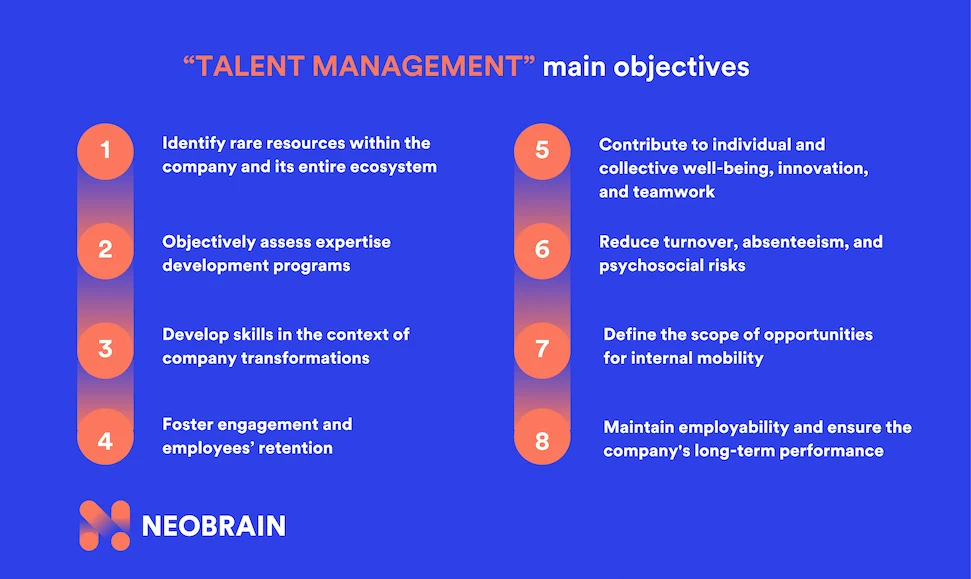According to a study by the Boston Consulting Group, talent management represents an annual budget of almost $40 billion worldwide.
This HR practice, previously reserved for the company’s highest potentials, is now a strategic asset within increasingly competitive organizations. Companies such as Facebook and Apple have demonstrated that practices dedicated specifically to talent are a vector for overall performance. ANDRH, through its Director, Audrey RICHARD, speaks of democratization in French companies, while raising new challenges.
How can we make talent management a differentiating factor? What best practices should be implemented?
The ambitions of talent management
Before detailing the objectives, let’s start by defining the notion of “talent” within your company.
What is a talent?
A talent is not just a distinctive skill , but an asset that can be developed to make a significant contribution to the organization. We often associate a "talent" with the individual who displays this extraordinary ability, but it can only be expressed with the support of a structure that encourages its daily expression.
What are the objectives of talent management?
This practice was born in 1997. Talent management has 8 main objectives:
- Identify the scarce resources within the company and those of its entire ecosystem
- Objectivize expertise development programs
- Develop skills in a context of business transformation
- Fostering employee commitment and loyalty
- Contribute to individual and collective development, innovation and teamwork
- Reduce turnover, absenteeism and psychosocial risks
- Define opportunities for internal mobility
- Maintain employability and guarantee the company’s performance over time.
This talent management practice has evolved from activities centered on the “People Review – High Potential – Succession Plan” cycle to a focus on strategic know-how. The main objective is to recognize the specific aptitudes of each individual, not just high potentials.
Talent embodies the fusion of skill and potential
What do we call “Skills”?
Originally a legal concept, skill evolved into a central HR concept after the economic crisis of the 70s. Today, skills management is seen as central to business performance, with " skillsshortage" and " skillsobsolescence" being the main priorities for HR teams. These skills data can be visible or immersed, and the talent of the HR activity will be to make the most of all of them in the service of performance.
What do we call “potential”?
This is a presumption of future high performance, the potential is only virtual.
So how do you assess an employee's potential?
Here is an example of 3 features used by a customer in the energy sector:
- Ability to challenge yourself tolearn quickly: humility, curiosity, willingness to learn…
- Good stress management and emotional stability,
- Ability totake the initiative and get buy-in for quick decisions
Talent management is therefore about identifying and developing 2 things: skill and nurturing potential.
This practice is therefore designed to create the right internal conditions for the synergy of these two aspects, with particular attention paid to the aspirations and values of each individual within a homogeneous whole.
Now let’s ask ourselves this question: What are the best talent management practices that will give you a competitive advantage?
The 4 Best Practices of Talent Management
Building a sustainable HR policy
Building an attractive HR offering therefore relies on knowledge of know-how. The tool provided by the mapping of skills key skills and their measurement criteria is a must. All this data is used to determine the KPIs(performance indicators) and the deviations from desirable levels. A “sustainable” policy is the combination of 2 approaches:
- Communication on proven career paths.
- Flexibility in the creation of individualized trajectories.
As a former recruiter, I've had the opportunity to work alongside major new technology companies that have made human capital a key success factor. Their high standards in terms of resources have always proved relevant, and by focusing on the exceptional aptitudes of their new recruits, they foster a culture of excellence. How do you identify and attract these 5-legged sheep?
Identify, attract and onboard new talent
HR strategy is based on the analysis of “gaps”, i.e. the expertise missing today or anticipated as essential tomorrow. Attracting and recruiting new talent is a strategic challenge for HR departments, as it is the meeting point between a company’s values, its employer brand, and its ability to find innovative and authentic responses to the expectations of its target population.
Another key element is the onboarding phrase.
Various studies point to a lack of interest on the part of companies in this onboarding phase, with Mercuri Urval reporting that 65% of companies simply don’t have an onboarding path. At Facebook, the onboarding phase lasts 6 weeks. This is the time needed for the employee to familiarize himself with the corporate culture, work tools and current innovation projects. They then choose the project they want to work on, which is a good way of ensuring their motivation. During this period, and especially since the spread of telecommuting, the notion of continuous conversation has become a key factor in successful recruitment.
Engage your talent pool
Is offering career paths that meet their expectations a solution to talent retention ? 81% of HR managers believe that internal mobility is one of the answers. Moreover, the Global Talent Trends 2020 study conducted by LinkedIn shows that employees of a company that has developed a strong internal mobility policy stay on average 41% longer.
Talent retention also depends on 6 factors that we identified during a study of 80 HR managers with the HR Lab:
Here are the 6 levers of engagement:
- Recognition or "symmetry of attention
- The collective dimension, sometimes forgotten by hybrid work
- Workplace relationships, the face-to-face environment and the culture it creates
- Measures to encourage employees in their career development
- The daily measurement of these different levers and the analysis of their evolution
These mechanisms are deployed for all employees, and, according to the president of ANDRH, the differences between talent management and employee management are tending to disappear. Nevertheless, there are still certain processes dedicated solely to the company’s talent population: the talent review or“people review”.
Have a real, measurable development objective
If some employees suffer from a lack of motivation linked to the content of their missions, the majority of employees expect their company to provide them with the means to develop their skills. The current challenge is not simply to offer these adapted development tools, but to anchor them in a mobility perspective.
2 out of 3 executives are considering internal or external mobility in the next 3 years.
It's by visualizing the bridges between professions that an employee takes the initiative to build his or her own progression plan. Neobrain has been recognized for its ability to connect all these activities.
Talent Management is a long-term policy, and its results can be seen after several years, making it a key activity for HR teams. Talent management, employee commitment and performance are directly linked: a company that implements a talent management policy sees its profits double in 50% less time than another (BCG study“The Global Leadership and talent index“).
In conclusion: our tips for successful talent management.
- Identify the company’s expertise needs: it’s important to know what key skills the company needs to achieve its objectives.
- Encourage internal mobility: it may be worthwhile allowing employees to change jobs or departments within the company, in order to offer them new professional experiences and help them enrich their know-how.
- Set clear career goals : It is important to communicate to employees about opportunities for advancement within the company and to help them define their career goals.
- Establish mentoring programs: Mentoring can be an effective way to transfer knowledge and expertise from more experienced employees to younger ones.
- Regularly assess employees’ performance and skills : it’s important to monitor employees’ skills and provide them with regular feedback to help them develop professionally.









